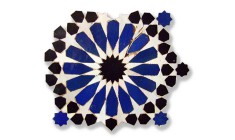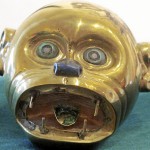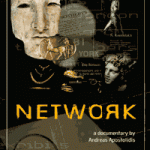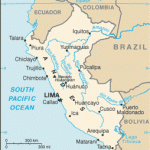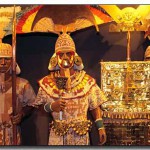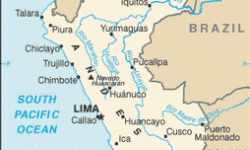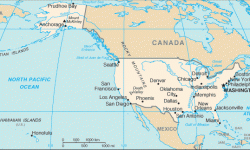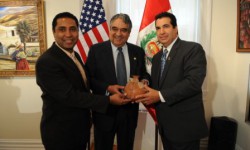Sipán Jewellery Offered for Sale at Sotheby’s (1994)
Author: Donna Yates
Last Modified: 04 Aug 2023
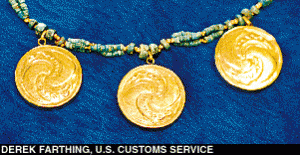
Several Peruvian antiquities offered for sale at Sotheby’s Auction House in 1994 that were seized by US Customs under suspicion of having been looted from Sipán.
Originally Published: 3 August 2012
Updated: 4 August 2023
In mid 1994 Sotheby’s auction house published the catalogue for sale number 6625 which was held on the 15th of November in New York (Sotheby’s Auction House 1994). Although the catalogue is filled with intriguing pieces of uncertain provenance and provenience, five lots are of particular interest:
- Lot number 7 was listed as a ‘Late Chavin Gold Head Bead’, dated to ‘700–400 B.C.’ and valued at ‘$4,000–6,000’ (Sotheby’s Auction House 1994). The piece did not sell at the 15 November auction.
- Lot number 10 was listed as an ‘Early Mochica Gold and Turquoise Effigy Ear Ornament’ dated to ‘300–100 B.C.’ and valued at ‘$20,000–30,000’ (Sotheby’s Auction House 1994). The piece did not sell at the 15 November auction.
- Lot number 11 was listed as a ‘Late Chavin Gold and Turquoise Necklace’, dated to ‘700–400 B.C.’ and valued at ‘$5,000-7,000’ (Sotheby’s Auction House 1994). The piece sold for $5,750 at the 15 November auction.
- Lot number 17 was listed as an ‘Early Mochica Turquoise and Gold Necklace’, dated to ‘300–100 B.C.’ and valued at ‘$1,200–1,800’ (Sotheby’s Auction House 1994). This piece sold for $6,325 at the 15 November auction.
- Lot number 18 was listed as an ‘Early Mochica Gold Ornament’, dated to ‘300–100 B.C.’ and valued at ‘$1,200–1,800’ (Sotheby’s Auction House 1994). This piece sold for $2,185 at the 15 November auction.
The catalogue contains neither contextual information nor ownership history for these objects. They are simply listed in a section bearing the subheadings ‘Peru‘ and ‘Property of Various Owners’ (Sotheby’s Auction House 1994).
Upon reviewing the catalogue in advance of the sale, officials at the Peruvian embassy in Washington D.C. and archaeologist Walter Alva recognised the Moche pieces as having come from the site of Sipán. Specifically, the design on the back of the gold beads of Lot 17 was nearly identical to those of the famous Sipán spider beads which were archaeologically excavated by Alva (Atwood 2004: 94). Alva believed that lot 11 (and perhaps lot 7), listed as ‘Chavin’, may actually have been from Sipán as well. With the backing of the Peruvian government, Alva requested that Sotheby’s return lots 7, 10, 11, 17, and 18 (Atwood (2004) makes no mention of lot 7 in his list; Rose (1996) records that lots 7, 11 and 17 were requested and makes no mention of lots 10 and 18). Alva asserted that the lots were in violation of the 1990 emergency restrictions placed on the import of Sipán material into the United States (Rose 1996). When Sotheby’s declined this request, the government of Perú formally contacted U.S. Attorney General Janet Reno and the U.S. Customs Agency in New York was given the order to recover the pieces (Rose 1996).
Sotheby’s was served with a seizure warrant for the suspected Sipán pieces on 14 December 1994, about a month after several of the pieces had been sold. Lots 7, 11, and 17 had been consigned by New York art dealer David Bernstein[1][2]; one of the pieces was recovered from the office of his counsel (presumably lot 7, the piece that had not sold at auction) and the other two were seized from a Sotheby’s warehouse (IFAR n.d.). The objects were taken to the New York Customs House pending investigation. Lots 10 and 18 were returned to Sotheby’s and subsequently sold (Atwood 2004: 95).
Lot 10 was purchased by Houston-based collector Alfred C. Glassell, Jr. Upon his death, the piece entered the collection of the Museum of Fine Arts, Houston (Object number 2010.1283; Museum of Fine Arts, Houston n.d.)
Following the seizure of the objects, Bernstein filed for their return claiming that the warrants used to confiscate the objects lacked probable cause (IFAR n.d.). The New York Federal District Court questioned if the objects actually came from Sipán but ruled that at the very least they had been smuggled into the United States illegally. Bernstein’s motions were denied because he could not demonstrate that hardship was caused by the seizure of the items (IFAR n.d.). The grand jury proceedings on this matter are unpublished. Eventually it was determined that lots 7, 11, and 17 should be repatriated to Peru. They were presented to then-president Alberto Fujimori on 21 May 1996 (Rose 1996)[3]. They are now in the collection of the Brüning Museum/Museo Tumbas Reales de Sipán in Lambayeque. They are thought to be the first Sipán objects seized and repatriated under the 1990 emergency cultural property restrictions (Rose 1996).
Alva believes that these pieces likely passed through the hands of Peruvian collector Raúl Apesteguía who was brutally murdered in his home by members of an antiquities cartel that he was involved with (Atwood 2004: 94).
References
Atwood, Roger (2004), Stealing History: Tomb Raiders, Smugglers, and the Looting of the Ancient World (New York: St. Martin’s Press).
IFAR (n.d.), ‘In re Search Warrant Executed Feb. 1, 1995’, <http://www.ifar.org/case_summary.php?docid=1179698827>, accessed 5 May 2012.
Museum of Fine Arts, Houston (n.d.), ‘Unknown Central and South American Pendant Depicting a Deity with the Body of a Stingray and the Head of a Human with Fangs’, Website of the Museum of Fine Arts, Houston, <https://web.archive.org/web/20230804184034/https://emuseum.mfah.org/objects/96814/pendant-depicting-a-deity-with-the-body-of-a-stingray-and-th?ctx=1613df5e9693c8c3a2fa8173e78c3ac81cc8ac3f&idx=30>, accessed 4 August 2023.
Rose, Mark (1996), ‘Jewelry Repatriated’, Archaeology, 49(5), 30.
Sotheby’s Auction House (1994), ‘Pre-Columbian Art (Sale number 6625)’, Sotheby’s Auction House, New York.
[1] It is unclear if Bernstein was the consigner on lots 10 and 18.
[2] The website for Bernstein’s dealership, ‘David Bernstein Pre-Colombian Art’ is http://www.precolumbianart4sale.com/html/home.asp. As of May 2012, his business was based on Park Avenue, New York.
[3] Sources disagree over which objects in the catalogue were seized and returned. Atwood records the returned objects as being lots 11 and 17. Rose includes lot 7 among the returns and lot 7 does appear in US Customs photographs. It seems likely that lot 7 was accidentally omitted by Atwood.
